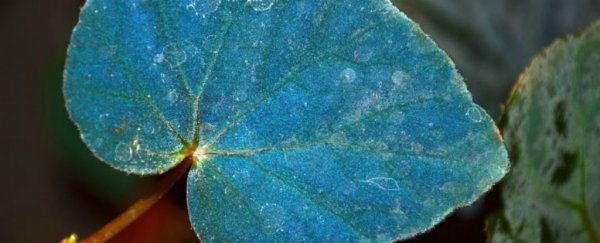Researchers have finally figured out why the peacock begonia (Begonia pavonina) - a plant found in the rainforests of Malaysia - glows blue, and it turns out it actually uses a quirk of quantum mechanics to slow light down and make photosynthesis more effective in near-darkness.
Yep, the peacock begonia's eerie blue glow is part of an evolutionary trick that allows it to harness more chemical energy through the photosynthesis of red-green light that hits the darkened forest floor where it grows.
"It's actually quite brilliant," team leader Heather Whitney, from the University of Bristol in the UK, told William Herkewitz at Popular Mechanics.
"Plants have to cope with every obstacle that's thrown at them without running away. Here we see evidence of a plant that's actually evolved to physically manipulate the little light it receives. It's quite amazing, and was an absolutely surprising discovery."
Whitney and her team discovered this unique trick by studying a crossbreed of the plant in the lab, which they had to use because the wild plant is too delicate to remove from its rainforest home.
The plant is of so much interest because its leaves are blue rather than green, which suggests that its chloroplasts - the structures inside a plant's leaves where photosynthesis takes place - are also blue. But no one has been able to figure out why.
Using an electron microscope, the researchers were able to examine the cellular structures inside the peacock begonia's leaves - specifically, the plant's chloroplast.
Inside these 'chloroplast capsules', the team noticed that the thylakoids - small sack-like structures inside the chloroplasts that react with light to produce the photosynthetic reaction - were arranged in a much more structured way than those found in other plants.
"Looking in more detail by using a technique known as electron microscopy, we found a striking difference between the 'blue' chloroplasts found in the begonias, also known as 'iridoplasts' due to their brilliant blue iridescent colouration, and those found in other plants," explains one of the team, Matt Jacobs.
"The inner structure had arranged itself into extremely uniform layers just a few 100 nanometres in thickness, or a 1,000th the width of human hair."
As Herkewitz reports, the thylakoids inside the begonia plant appeared to be intricately placed in a specific pattern like the skyline of a planned city. In other plants, thylakoids are seemingly spread all over with no rhyme or reason like the skyline of the more-chaotic Manhattan.
While this is interesting on its own, this structured pattern actually performs a couple of amazing feats that separate begonias from other plants. One example is that it allows blue light to be reflected away from the plant, allowing more red-green light to enter.
This is vital, because on the forest floor - with such a dense canopy overhead - the little plants barely receive any blue light anyway, meaning that it's optimised for the wavelength of light that it predominately receives.
But tcoolest and most interesting aspect of the plant's thylakoid arrangement is what it does to light itself. The structure of the thylakoids is set up in such a way that it slows light down as it enters the plant cells, creating an effect called slow light.
This creates a double whammy of photosynthetic power, because the plant is already about to absorb more red-green light, and can also slow the travel of that light, keeping it around longer to suck up more chemical energy from it.
The team found that these two buffed up the plant's chloroplasts and increased photosynthesis by around 10 percent. That means, from the same amount of sunlight, the plants are able to generate 10 percent more chemical energy.
"It's just wonderful and logical to think that a plant has evolved an ability to physically manipulate the lighting around it in a variety of different ways," Whitney told Popular Mechanics.
"I think it really raises the prospect that this type of phenomenon might even be more widespread than we realise in the plant kingdom. Perhaps we just don't notice other plants that are doing this because they don't have a strange colour."
The team's work was published in Nature Plants.
